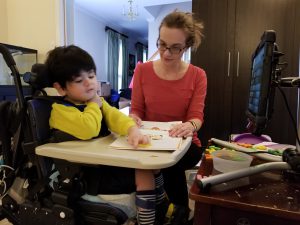 One surprising aspect of Joey’s communication growth over the last year has been to watch how his overall methods of communication increased along with his use of his Alternative and Augmentative Communication (AAC) device. I often hear people fear that using an AAC device will mean that a child stops developing oral language, because he no longer has a need for it. I hear this from teachers and parents, and frankly, the first time anyone told me about an AAC device I asked the same thing. “If he can push a button and get what he wants, why on earth would he ever speak again?” “If he can talk, then why would we introduce him to a way of communicating that does not involve oral language?”
One surprising aspect of Joey’s communication growth over the last year has been to watch how his overall methods of communication increased along with his use of his Alternative and Augmentative Communication (AAC) device. I often hear people fear that using an AAC device will mean that a child stops developing oral language, because he no longer has a need for it. I hear this from teachers and parents, and frankly, the first time anyone told me about an AAC device I asked the same thing. “If he can push a button and get what he wants, why on earth would he ever speak again?” “If he can talk, then why would we introduce him to a way of communicating that does not involve oral language?”
It’s a tricky question, and understandable when AAC is a new concept to someone. Yet, what we’ve found so far in watching Joey’s development of communication (and in discussions with special education teachers who work in schools) is that the introduction of an AAC device seems to open up children’s understanding of how they can interact in their environment. This understanding builds a sense of self, and sense of agency for children.
For Joey, we initially saw a growth in how he used gestural communication with us. He began pointing to convey his message, or even trying to move our hands toward what he wanted. He’s become more verbal, making oral utterances, and then looking or pointing in a general direction to communicate what he is trying to tell us. Joey no longer felt he needed to simply cry or laugh to get what he wanted. Instead, he had options, even when he did not have access to the AAC device.
It seems that the use of the AAC device helped Joey’s overall development. Instead of just teaching him vocabulary and giving him the opportunity to use, it is allowing him to go through developmental stages that open up his understanding of how he can interact with the world.


